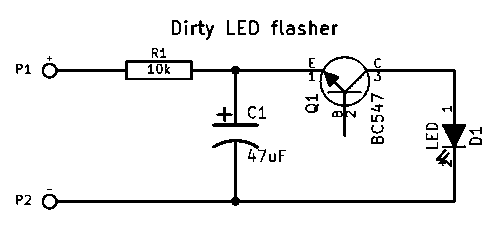
Schematic diagram (click for full resolution)
This circuit is extremely simple. The operating voltage is around 15 volts. There are only 4 parts - a resistor (R1), a capacitor (C1), an NPN transistor (Q1) and an LED (D1). It's a fairly popular circuit that can be found on the Internet in many variants.
The operating principle is fairly simple and uses an interesting function/property of bipolar transistors. When the voltage between the transistor's collector and emitter gets below some negative value (past the transistor's rated limit), "non-destructive" (note: full destruction typically won't occur, however the amplification factor will be reduced, and this effect is very significant after longer run-time) breakdown occurs and the transistor starts conducting. It stops conducting when the current drops below a certain level. Basically the transistor acts like a diac, or a similar device that exhibits negative differential resistance. In this circuit, this results in C1 getting discharged into the LED, causing it to flash. The capacitor then gets charged again through R1, until the voltage reaches a certain level, and this cycle repeats over and over. The charge current is limited by R1 to a low value, limiting the flash rate and making it possible for the transistor to stop conducting.
Simple functional description - C1 gets charged through R1, when the voltage gets high enough, Q1 breaks down and current starts to rise, C1 discharges into D1 through Q1, current starts to drop and Q1 stops conducting, then C1 starts charging through R1 again.
This circuit has a huge disadvantage - it only works with some transistors. Personally, I had good luck with BC547 (BC547A, BC547C), BC337-25 and BD139. Some transistors, such as C945, don't work in this circuit at all. Results may vary depending on the transistor type, manufacturer or even the individual transistor. Also, different transistors (even from the same series) have a different breakdown voltage. The flash frequency also varies heavily with the input voltage. This circuit is a curiosity, not something that should be used in a production environment.
The biggest advantage of this circuit is its simplicity. However, it relies on offically undocumented properties, so it may not work properly with some transistors, and its behavior (frequency...) is somewhat unpredictable.
Tested transistors - keep in mind that results may vary depending on manufacturer or even the individual transistor! IIRC, the BC547C, BC547A, BC546B, BC337-16 and 2N5551 transistors I tested were new and manufactured by Diotec Semiconductor.